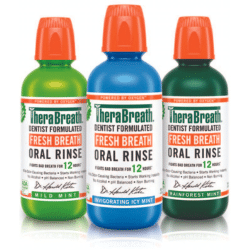Clinical Insights: The Science Under the Orange Cap
Learn how TheraBreath™ Fresh Breath Mouthrinse starts working instantly to help fight the bacteria that cause oral malodor.
After dental caries and periodontal disease, oral malodor, also known as halitosis or bad breath, is one of the leading causes for patients to visit their dental office.1 Because of this, you should be aware of over-the-counter hygiene products that can help your patients effectively fight oral malodor.

and is available in Mild Mint, Icy Mint, and Rainforest Mint.
Oral malodor describes an unpleasant smell that emanates from the mouth and can be perceived by others.1 Approximately 25% of Americans are affected by oral malodor.2 Although oral malodor can become severe, it is often not serious, but can still impact patients socially and psychologically, compromising their quality of life.1,2
Oral Malodor and the Role of Anaerobic Bacteria and Volatile Sulfur Compounds
Research shows the cause of oral malodor is multifactorial and has been associated with anaerobic bacteria. The production of volatile sulfur compounds (VSCs) by microbial degradation of proteins, peptides, and amino acids has been identified as a source of malodor.2
VSCs are primarily hydrogen sulfide, methyl mercaptan, and dimethyl sulfide and are thought to be the main cause of oral malodor.1 The VSC-producing anaerobic bacteria of the oral microbiome include Fusobacterium nucleatum, Porphyromonas gingivalis, and Tannerella forsythia.1,2
Powered by Oxygen™
The pH balanced TheraBreath™ Fresh Breath mouthrinse (Figure 1) is part of a full line of condition-specific rinses (Figure 2). The mouthrinse was specially formulated by a dentist to kill odor-causing bacteria for long-lasting fresh breath. The ingredient responsible for the rinse’s clinically shown efficacy against bad breath is stabilized sodium chlorite (0.1%), an oxidant compound.1
Mechanism of Action and Proof of Efficacy
The sodium chlorite in Fresh Breath rinse fights the anaerobic bacteria producing malodorous VSCs. It works by harnessing the power of oxygen to create an oral environment where anaerobes can’t survive—all without the addition of alcohol.
In a pilot study, Dinis et al2 presumed sodium chlorite’s method of action to be the creation of an oxygenated local environment that becomes inhospitable to anaerobic bacteria. Study findings supported their hypothesis, as the alcohol-free Fresh Breath mouthrinse had a greater effect than a control against oral malodor-associated anaerobes, such as F. nucleatum. This rinse was also shown to maintain the overall oral microbial diversity, suggesting its antimicrobial activity only against certain halitosis-associated bacteria.2
Concomitantly, the results of a clinical trial by Pham and Nguyen1 demonstrate that Fresh Breath significantly reduces oral malodor and concentrations of hydrogen sulfide and methyl mercaptan, as well as decrease levels of anaerobic bacteria, such as F. nucleatum and T. forsythia, in saliva. They also found that the rinse fights bad breath for up to 12 hours.1

The TheraBreath™ Difference: Science and Beyond
The science under the orange cap ensures you can be confident you are recommending an effective rinsing solution in TheraBreath™. Beyond science, there is honesty and purpose in each bottle. Honesty represents how the rinses are formulated with intentionally selected ingredients and without alcohol, sulfates, parabens, and dyes. The purpose is the dedication to help your patients improve their oral health with a better mouthrinse.
TheraBreath™
800-447-6666
References
- Pham TAV, Nguyen NTX. Efficacy of chlorine dioxide mouthwash in reducing oral malodor: a 2-week randomized, double-blind, crossover study. Clin Exp Dent Res. 2018;4:206–215.
- Dinis MB, Agnello M, He X, Shi W, Tran NC. Pilot study on selective antimicrobial effect of a halitosis mouthrinse: monospecies and saliva-derived microbiome in an in vitro model system. J Oral Microbiol. 2021;13:1–9.
From Dimensions of Dental Hygiene. April 2023; 21(4):25.

